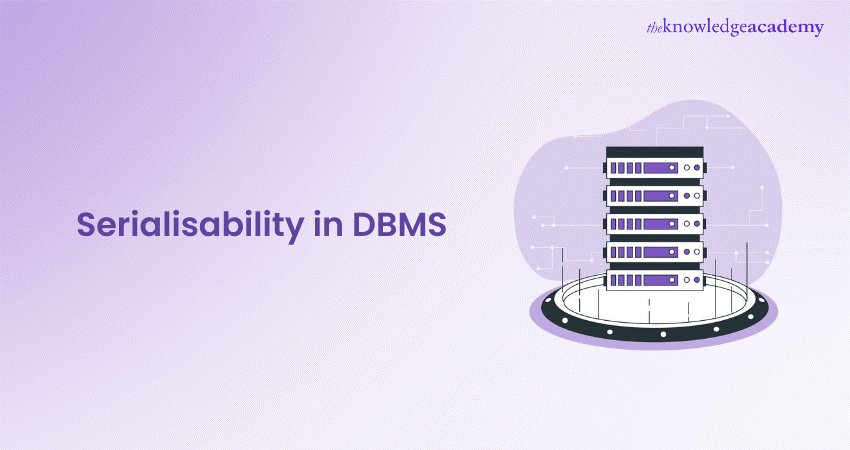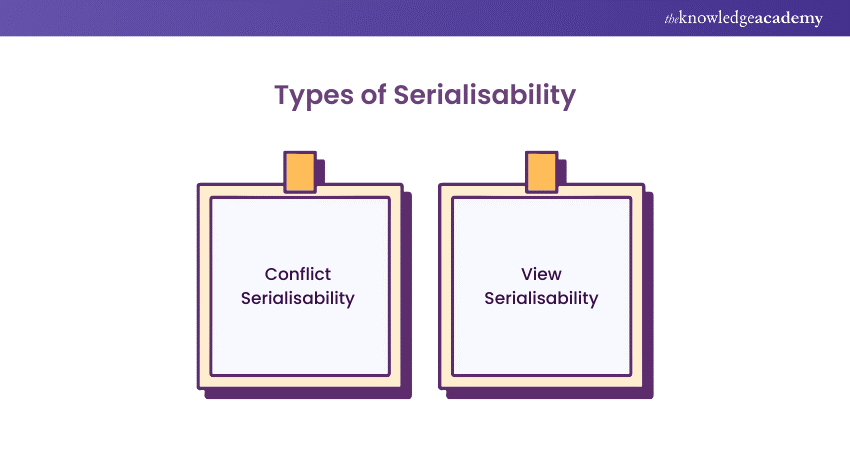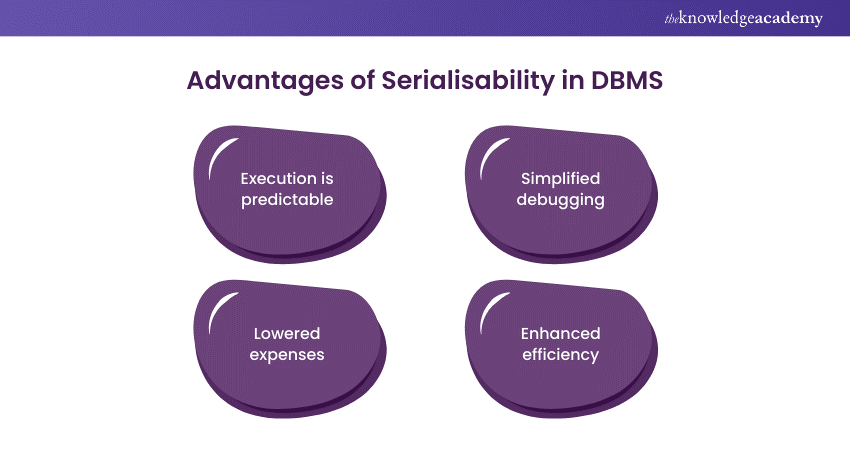We may not have the course you’re looking for. If you enquire or give us a call on 01344203999 and speak to our training experts, we may still be able to help with your training requirements.
Training Outcomes Within Your Budget!
We ensure quality, budget-alignment, and timely delivery by our expert instructors.

We will delve into an in-depth exploration of the concept of Serialisability and its profound impact on Database Management Systems (DBMS) through this blog. This fundamental concept significantly influences the core functionality of DBMS, which serves as the bedrock for numerous modern applications. Our understanding of Serialisability is further enriched through illustrative examples, shedding light on its practical application.
Serialisability in DBMS ensures that running multiple transactions in parallel will not result in any unexpected or inaccurate outcomes. We will underscore the pivotal importance of Serialisability through a real-world example, highlighting its role in optimising performance and providing efficient storage solutions when crafting the foundation of DBMS forms for contemporary applications. Read more to learn more!
Table of Contents
1) What is Serialisability in DBMS?
2) What is a Serialisable schedule?
3) Different types of Serialisability
4) Advantages of Serialisability in DBMS (Database Management System)
5) Examples for testing Serialisability in DBMS
6) Conclusion
What is Serialisability in DBMS?
In computer science, Serialisability is a term that characterises a system property governing how distinct processes interact with shared data. If the outcomes produced by the system align with the operations it performs, we deem that system as Serialisable. In this context, cooperation within the system implies a need for more overlap in data execution. In Database Management Systems (DBMS), when data is either written or read, the DBMS can prevent other processes from accessing that data.
DBMS utilises various locking mechanisms within the MongoDB developer certificate to permit concurrent processes while upholding data integrity. In MongoDB, the most stringent level of Serialisability is constrained by two-phase locking, commonly known as 2PL. In the initial phase of this locking system, data objects are locked before the execution of operations. Once the transaction is completed, the lock on the data object is released. This process ensures conflict-free functions, presenting a unified database view of all transactions.
The Two-Phase Locking (2PL) system furnishes a robust assurance against conflicts in the database. It can alleviate performance degradation by managing the overhead of acquiring and releasing data locks. Consequently, this system facilitates constrained Serialisability, enhancing the overall performance of the DBMS. This guarantees that the result aligns with some sequential execution, optimising the database operations.
What is a Serialisable schedule?
In a Database Management System (DBMS), a Serialisable schedule is a sequence of database actions (read and write operations) that does not violate the serialisability property. This property ensures that each transaction appears to execute atomically and is isolated from other transactions' effects. The Serialisability of schedules in DBMS must be equivalent to some serial schedule of the duplicate transactions. In other words, the program must produce the same results as if the transactions were executed one at a time in some order.
Several algorithms can be used to check for a Serialisable schedule in DBMS. One such algorithm is the conflict Serialisability algorithm, which checks for potential transaction conflicts. A conflict occurs when two transactions try to access the same data item in conflicting ways (e.g., one transaction tries to read a data item while another transaction writes to it). If there are no conflicts, the schedule is guaranteed to be Serialisable. However, if there are conflicts, the program may or may not be Serialisable.
Another algorithm that can check for Serialisability is the view Serialisability in the DBMS algorithm, which checks for potential mutual dependencies between transactions. A mutual dependency exists when two transactions depend on each other for their respective outputs to be correct. The schedule is guaranteed to be Serialisable if there are no mutual dependencies. However, if there are mutual dependencies, the schedule may or may not be Serialisable.
Different types of Serialisability
The following are the different types of Serialisability:

1) Conflict Serialisability
Conflict Serialisability pertains to a subset of Serialisability, concentrating on upholding the coherence of a database while ensuring the orderly execution of identical data items. Each transaction possesses a distinct value in a Database Management System (DBMS), and the entire database relies on this uniqueness. This distinctiveness ensures that concurrent occurrences of operations with the same conflicting value are prohibited.
For instance, let's consider an order table and a customer table as two instances. Every order is linked to a specific customer, even though a single client may place multiple orders. There are constraints to achieving conflict Serialisability in the database. Here are a few of them:
1) Different transactions must be utilised for the two procedures.
2) The identical data item should be present in both transactions.
3) Between the two operations, there should be at least one write operation.
Register for our Relational Databases & Data Modelling Training now and take the next step towards becoming a database pro!
2) View Serialisability
View Serialisability takes a more abstract perspective, considering the results visible to users rather than the specific operations performed. It emphasises the order in which transactions' results are presented, providing a higher-level understanding of consistency.
View Serialisability constitutes a category of operation within Serialisability, where each transaction is required to yield specific results, and these outcomes correspond to the results of correctly sequential execution of the data item. Unlike conflict Serialisability, view Serialisability focuses on preventing database inconsistency. The view Serialisability functionality of a DBMS empowers users to perceive databases in conflicting manners.
Advantages of Serialisability in DBMS (Database Management System)
Now that we have understood Serialisability in DBMS, let's explore some advantages of Serialisability in Database Management Systems.

1) Execution is predictable
With the execution of all threads occurring sequentially, there are no surprises. Variables are updated as anticipated, and there is no data loss or corruption risk.
2) Simplify the debugging
The solitary execution of each thread makes it more straightforward to comprehend the actions and motivations of each thread. This simplicity facilitates the debugging process, eliminating concerns related to concurrency issues.
3) Lowered expenses
Serialisation in DBMS contributes to cost reduction, both in terms of hardware and software. Hardware costs are minimised by allowing fewer resources for a given computation, such as employing a single CPU instead of two. Additionally, it aids in reducing software development costs by enhancing code clarity and diminishing the need for extensive testing involving multiple concurrently running threads.
4) Enhanced efficiency
There are instances where Serialisable executions outperform their non-Serialisable counterparts. This is attributed to the flexibility they provide developers, enabling them to optimise their code for performance. The controlled execution sequence optimises strategic code, enhancing overall system performance.
The benefits of Serialisability in DBMS extend to providing predictability, simplifying the debugging process, reducing costs on both hardware and software fronts, and even boosting performance in specific scenarios.
Join our specialised Teradata Training and dive deep into advanced querying, optimisation strategies, and data warehousing!
Examples for testing Serialisability in DBMS
Testing for Serialisability in a Database Management System (DBMS) is a crucial aspect of ensuring the consistency and reliability of transactions. Several methods and examples can be employed to validate Serialisability. Let's explore a few examples for testing Serialisability in DBMS.
1) Precedence graphs: One standard method is the use of precedence graphs. These graphs help visualise the dependencies and conflicts between transactions. Each transaction is represented as a node, and edges depict the order of conflicting operations. A cycle in the graph indicates a potential conflict, which can be addressed to achieve Serialisability.
2) Serialisation graphs: Like precedence graphs, Serialisation graphs visually represent the order of transactions. Nodes represent transactions, and edges indicate the order of execution. Detecting cycles in Serialisation graphs helps identify potential conflicts and ensures Serialisability.
3) Conflict Serialisability matrix: Another method involves creating a conflict Serialisability matrix. This matrix captures the conflicts between pairs of transactions, helping to identify conflicting operations and ensure that they are appropriately ordered for Serialisability.
4) Testing with database snapshots: Generating database snapshots at various points during execution and analysing data consistency can be a practical approach. If the final state of the database remains consistent across different snapshots, Serialisability is likely maintained.
Ready to conquer time-series data analytics? Join our specialised InfluxDB Training and delve into the world of high-performance, scalable data storage and analysis.
Conclusion
To qualify as Serialisable in a Database Management System (DBMS), a transaction must align with the ACID properties in DBMS. In DBMS, Serialisability manifests in diverse forms, each with its unique set of advantages and drawbacks. Opting for the optimal type of Serialisability often necessitates a delicate balance between performance and correctness. We hope you have understood Serialisability in DBMS through this blog!
Supercharge your career with our comprehensive Database Training.
Frequently Asked Questions

Serialisability in DBMS refers to the property that ensures transactions appear to be executed in a sequential order, even though they may be executed concurrently. It guarantees that the final state of the database is equivalent to some serial execution of the transactions, which means that the results of concurrent transactions are consistent with those of a serial execution.

Serialisability is crucial in DBMS to maintain the integrity and consistency of the database. It prevents anomalies such as lost updates, uncommitted data, and inconsistent reads that may occur when multiple transactions execute concurrently. By enforcing serialisability, a DBMS ensures that the database remains in a valid state, adhering to the ACID properties (Atomicity, Consistency, Isolation, Durability), and provides a reliable foundation for concurrent transaction processing.

Serialisability can be achieved in a database system through the implementation of concurrency control mechanisms. Two common techniques are locking and timestamp ordering. Locking involves acquiring and releasing locks on data items to control access, ensuring that only one transaction can modify a specific data item at a time. Timestamp ordering assigns a unique timestamp to each transaction and orders their execution based on these timestamps, guaranteeing a consistent and Serialisable outcome. Both methods help manage concurrent access to the database and maintain the desired level of isolation among transactions.

The Knowledge Academy takes global learning to new heights, offering over 30,000 online courses across 490+ locations in 220 countries. This expansive reach ensures accessibility and convenience for learners worldwide.
Alongside our diverse Online Course Catalogue, encompassing 17 major categories, we go the extra mile by providing a plethora of free educational Online Resources like News updates, blogs, videos, webinars, and interview questions. Tailoring learning experiences further, professionals can maximise value with customisable Course Bundles of TKA.

Explore DevOps Courses with The Knowledge Academy, where more courses await, including Certified DevOps Professional (CDOP), Ansible Essential Training and Kuberflow Training. Tailored for various skill levels, these courses offer in-depth insights into Developer methodologies.
Dive into our, a trove of resources covering DevOps topics. Whether you are a beginner or aiming to enhance your Programming & DevOps skills, The Knowledge Academy's diverse courses and insightful blogs are your go-to source.

The Knowledge Academy’s FlexiPass is a pre-paid training voucher that is built specifically for clients and their dynamic needs. It provides access to a wide range of courses, at a pre-determined price, with robust safety measures. FlexiPass gives clients the added benefit of upskilling on a budget that best fits them.
Upcoming Programming & DevOps Resources Batches & Dates
Date
 Redis Cluster Database Training
Redis Cluster Database Training
Fri 28th Feb 2025
Fri 4th Apr 2025
Fri 27th Jun 2025
Fri 29th Aug 2025
Fri 24th Oct 2025
Fri 5th Dec 2025







 Top Rated Course
Top Rated Course



 If you wish to make any changes to your course, please
If you wish to make any changes to your course, please


